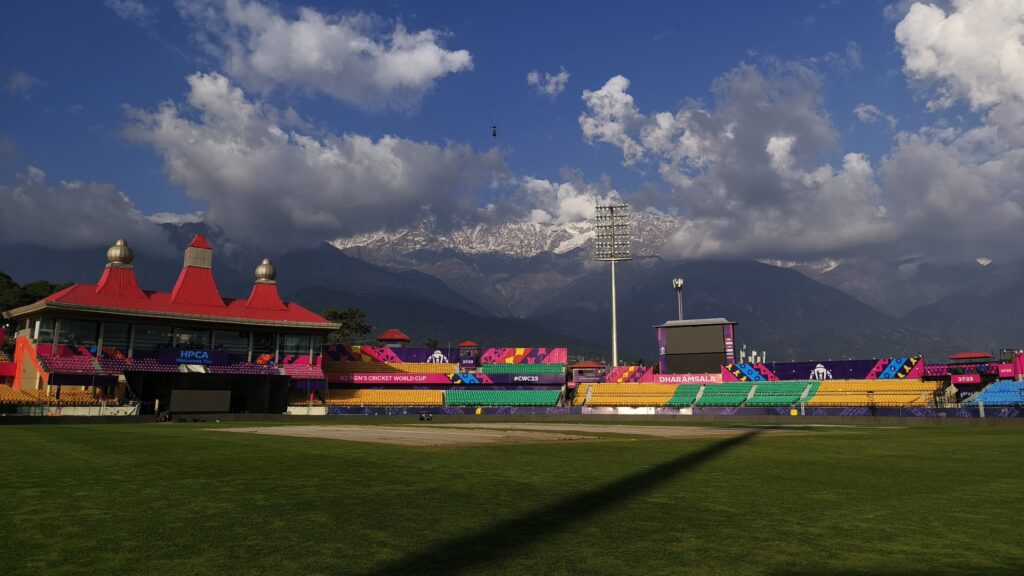
The images from Dharamsala look picturesque, that is, if you are viewing it through the prism of tourism. At a time when climate change and global warming have become a concern in every nook and corner of the world, this cricket venue which will host the fifth Test match between India and England from Thursday is freezing.
Usually, in March, Dharamsala is sunny, after the wretched winter. The Barmy Army is already there, enjoying sunshine, off and on. However, Day 1 of the Test is most likely going to be wet, according to all the weather reports. The idea that we could be playing in almost-English conditions borders on the perverse.
As hosts, India should be playing at a venue which suits Rohit Sharma and the team, not where it’s four degrees Celsius in the morning when they’re wake, and where even limbering up becomes difficult. The conditions in the preceding four Tests were just the opposite.
Are India trying to be gracious host or did the people in charge of preparing the itinerary for the Indian cricket board (BCCI) turn myopic? Ideally, after sealing the series 3-1, India should aim to drive the last nail into the coffin and make it 4-1 in Dharamshala.
Despite the complex matrix of ranking points in the ICC Test Championship cycle, India are well on course to make a third straight final. However, the way matches have been allotted to centres which are not regular Test venues defies logic.
Also Read: Sindhu has what it takes to win a third Olympic medal: Gopichand
When Test cricket is played in England or Australia, the venues are well known. The Oval, Lord’s, Edgbaston, Headingley – all this is like A, B, C for fans who have followed cricket. Similarly, the Melbourne Cricket Ground (MCG), The SCG in Sydney and the Gabba in Brisbane ring a bell when you think of traditional Test centres.
That tradition has been toyed with in cricket is no secret for the discerning. Yet, for the BCCI to have allotted Test matches to centres with no rich cricket history is depressing. Yes, nothing was wrong with the venues where the previous four Tests were played – Hyderabad, Vizag, Rajkot and Ranchi. But with the exception of Hyderabad, not one could be called a Test centre. Now, the caravan is in Dharamsala, as though in need of a tourist break.
In the old days, Tests were allotted to centres on the basis of tradition, knowledge of the crowd, and history. Over decades,, this was the practice. The Eden Gardens in Kolkata, the MA Chidambaram Stadium in Chennai, the Chinnaswamy Stadium in Bengaluru, the Wankhede Stadium in Mumbai and even the rechristened Arun Jaitley Stadium near the ramparts of the Feroz Shah Kotla in Delhi have been famous Test centres. The old Green Park in Kanpur was never quite in the same league.
Indeed, the advent of the Indian Premier League (IPL) in 2008 has seen more cricket centres come up in India. Ranchi or Raipur, these centres have good facilities. But then, Test cricket is still about tradition, romanticism and ensuring knowledgeable crowds turn up.
Cricket fans of this generation may have Google and a clutch of cricket apps/sites to rattle off stats and figures. But this was not the case in Calcutta, Madras, Bangalore and Bombay, as these cities were originally known. Those names may have been tweaked, but they continued to be cricket centres that hosted Test matches of great value and importance.
One can and should promote cricket, build new stadia and encourage more cricketers to come from mofussil centres. But Test cricket has a tradition and romance which should not fall foul of innovation. For the marquee venues to have been overlooked is baffling, nay shocking. Neither team complained, including the visitors. But if you looked at the crowd turnout at these four centres which hosted the Indian-England Tests, it was ordinary. In comparison, when the first leg of the Women’s Premier League was held in Bengaluru, more fans showed up.
Each Test series is serious business. A five-Test series is a luxury and still holds enormous interest for fans across the world. Why tinker when there is no need? Why try and move Test matches to a place like Ranchi where cricket is not the main sport, but hockey or archery is? Yes, MS Dhoni, the former India captain, hails from Ranchi, but the crowd turnout was nothing to write home about.
At this point, some numbers are instructive. In the past decade, Lord’s has hosted 18 Tests, and The Oval 10. The northern outpost of Headingley, scene of some of England’s greatest triumphs, had seen nine matches. What of India’s three most storied venues? The Eden Gardens has hosted three Tests since 2014, the same number as Chepauk. The Wankhede has seen just two matches.
Most of the cricket writers from England are comparing Dharamsala with venues back home! Are India trying to please the visitors or is Test cricket being reduced to a charade? Even when Dharamsala hosted matches in the ICC World Cup last year, the small stadium seemed an anomaly. Big Test centres fit in more fans, so why make do with venues that seat just over 20,000?
Dharamsala is a good resort for tourists, especially those who love nature with a strong chill in the air. Having played four Tests in warm weather where conditions were typically Indian and the wickets were prepared well, Dharamsala seems like a recipe gone wrong.
India have done incredibly well in this series, courtesy the bowling of the spin troika and Jasprit Bumrah. All of a sudden, Dharamsala could see moisture on the pitch and may be even sleet. Whoever though of finishing such an engrossing series in the deep freeze must have an active imagination. Performance or perfidy, what lies in store?
For the Latest Sports News: Click Here



